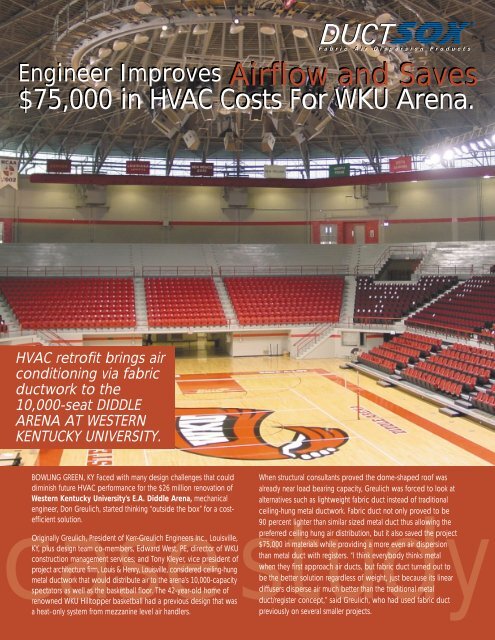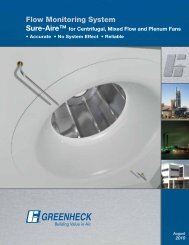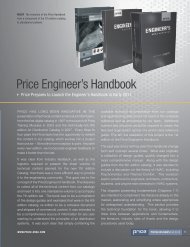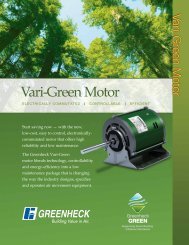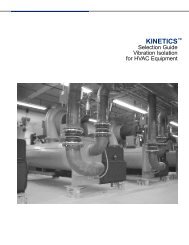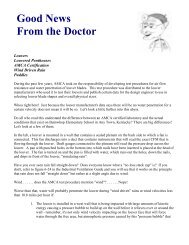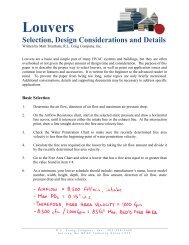WKU - R.L. Craig Company, Inc.
WKU - R.L. Craig Company, Inc.
WKU - R.L. Craig Company, Inc.
- No tags were found...
You also want an ePaper? Increase the reach of your titles
YUMPU automatically turns print PDFs into web optimized ePapers that Google loves.
Engineer Improves Airflow and Saves$75,000 in HVAC Costs For <strong>WKU</strong> Arena.HVAC retrofit brings airconditioning via fabricductwork to the10,000-seat DIDDLEARENA AT WESTERNKENTUCKY UNIVERSITY.BOWLING GREEN, KY Faced with many design challenges that coulddiminish future HVAC performance for the $26 million renovation ofWestern Kentucky University’s E.A. Diddle Arena, mechanicalengineer, Don Greulich, started thinking “outside the box” for a costefficientsolution.case studyOriginally Greulich, President of Kerr-Greulich Engineers <strong>Inc</strong>., Louisville,KY, plus design team co-members, Edward West, PE, director of <strong>WKU</strong>construction management services; and Tony Kleyer, vice president ofproject architecture firm, Louis & Henry, Louisville, considered ceiling-hungmetal ductwork that would distribute air to the arena’s 10,000-capacityspectators as well as the basketball floor. The 42-year-old home ofrenowned <strong>WKU</strong> Hilltopper basketball had a previous design that wasa heat-only system from mezzanine level air handlers.When structural consultants proved the dome-shaped roof wasalready near load bearing capacity, Greulich was forced to look atalternatives such as lightweight fabric duct instead of traditionalceiling-hung metal ductwork. Fabric duct not only proved to be90 percent lighter than similar sized metal duct thus allowing thepreferred ceiling hung air distribution, but it also saved the project$75,000 in materials while providing a more even air dispersionthan metal duct with registers. “I think everybody thinks metalwhen they first approach air ducts, but fabric duct turned out tobe the better solution regardless of weight, just because its lineardiffusers disperse air much better than the traditional metalduct/register concept,” said Greulich, who had used fabric ductpreviously on several smaller projects.
“Fabric duct provided a good solution to the structural hurdles wefaced with the Diddle renovation,” said West, “plus it also providedsome aesthetic value from something you would normally wanthidden ductwork.”Added, Louis & Henry’s Tony Kleyer: “By not adding weight to theroof, the fabric duct allowed us to do many other things that wouldhave been impossible with the weight load of metal duct, such asadding catwalks and television platforms.studyGreulich specified TufTex fabric duct by fabric duct manufacturer,DuctSox, Dubuque, IA. Installed by sheet metal sub-contractor,Haase Heating & Air Conditioning, Henderson KY, and overseen bymechanical contractor Hussung Mechanical Contractors <strong>Inc</strong>., Louisville,the 720 linear feet of round 36-inch-diameter duct is positioned 30feet above the spectator section and 70 feet from the basketball floor.Through the facilitation efforts of manufacturer’srepresentative, R. L. <strong>Craig</strong> <strong>Company</strong> <strong>Inc</strong>., Louisville,factory engineers used computer aided design(CAD) modeling to design ductwork airflowfeaturing both long-throw orifices and airdispersing linear vents. Specifically the airdispersion is designed as such: 1) six-inchdiameterorifices at 4 o’clock targeting thecourt; 2) a 1-1/8th-inch linear mesh vent at 5o'clock targeting the seats; 3) a 1/4-inch-widelinear mesh vent at 6 o’clock targeting seatingbelow the duct; 4) a 1/2-inch-wide mesh ventat 8 o’clock targeting more seating. “This is thefirst DuctSox application that has combinedlinear mesh vents and long-throw orifices,”said Nick Paschke, DuctSox's midwest regionalsales manager.While the previous system was considered noisy,the design team reduced HVAC operational noisesubstantially. Even though fabric transmits lessHVAC mechanical noise than metal duct, Greulichalso specified duct attenuators by CommercialAcoustics, Phoenix, AZ, and 18 Trane, Tyler, TX,12,000-cfm air handlers with built-in soundattenuation characteristics.To the delight of Louis & Henry Group’s Kleyer, the custom-colored“Hilltopper” red duct hangs aesthetically like a banner when not suppliedwith air. Large diameter fabric duct from 38-inch to 80-inch in diameterrequires a dual rail system for aesthetics and weight-bearing purposes.Since only a single H-track rail would allow the duct to hang like a banner,Greulich and Kleyer purposely specified the largest diameter DuctSoxpossible (36-inch-diameter) for single rail hanging and then built thesupply air portion of the HVAC systems around the duct size. “Usingthe fabric duct system as a continuous <strong>WKU</strong> red colored “banner”inside this circular building gave the Design Team yet another opportunityto provide visual excitement for the renovated building’s interiorenvironment. The red banner really has added an addition layer ofaesthetic richness for the Diddle Arena renovation. It has helped tobring a 20th century building into our current century,” added Kleyer.aseThe rail system was easily hung with Gripple <strong>Inc</strong>. Batavia, IL, hangersattached to the domed open ceiling architecture structure. Since theductwork is easily disassembled, the university is considering silk-screeningits logo or paid advertising logos on the duct when it’s taken downfor future laundering.The air handlers are supplied with two new 400-ton Trane chillers.Heating is handled with each air handler’s on-board 4 million-BTUboiler. Although the university has a district steam plant, Greulich specifiedon-board boilers for better control since the district system doesn’tprovide heat year-round.The building is controlled to a temperature range of 68°F to 75°F witha Johnson Controls, Milwaukee, WI, Metasys building control system. Ifeither temperature is surpassed, heat or cooling is activated. Greulichdesigned the space for continuous ventilation however, that’s efficientlycontrolled by proportionate control valvesthat mix make-up air with re-circulated air inthe air handlers. Outside air is introduced asneeded and is determined by CO2 sensorsthat open or close outdoor dampers on eachair handler.Cad overview of the system, 18 AHUUsing fabric duct also added to the expediencyof the project, which had to be completedby November’s first basketball game after theentire arena was gutted except for the floorand seating four months earlier. The fabricwas installed in approximately two weekswhile metal duct could have taken almosttwice as long, according to Mike Kleinhenz,project manager, Hussung MechanicalContractors.Additional time and money was saved withfabric duct when the air distribution designneeded a rerouting soon after installation toallow site lines to two large screen monitorsand luxury skyboxes that were late add-ons tothe arena’s design. Rerouting metal ductworkwould have delayed the project an extra weekor two versus the modification of fabric duct.Instead, Ductsox’s re-engineered lateral and verticalchanges that included eight 45-degree elbows and 18 tees completewith factory-installed internal flow straightening devices based onHussung’s field measurements. The additional ductwork was completedwith an estimated cost savings to the university of $10,000 versusmetal duct, according to Greulich. 4343 Chavenelle Road Dubuque, IA 52002-2654866-382-8769 www.ductsox.com563-589-2754/FAX


